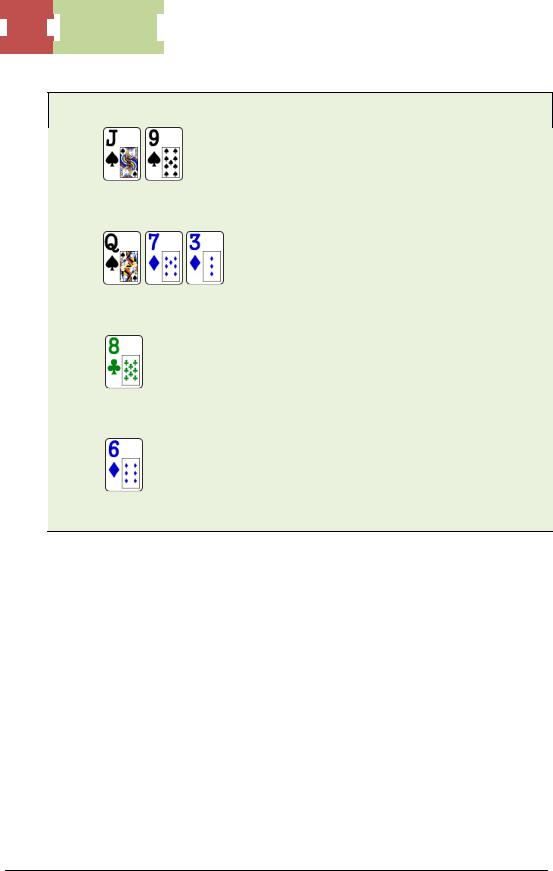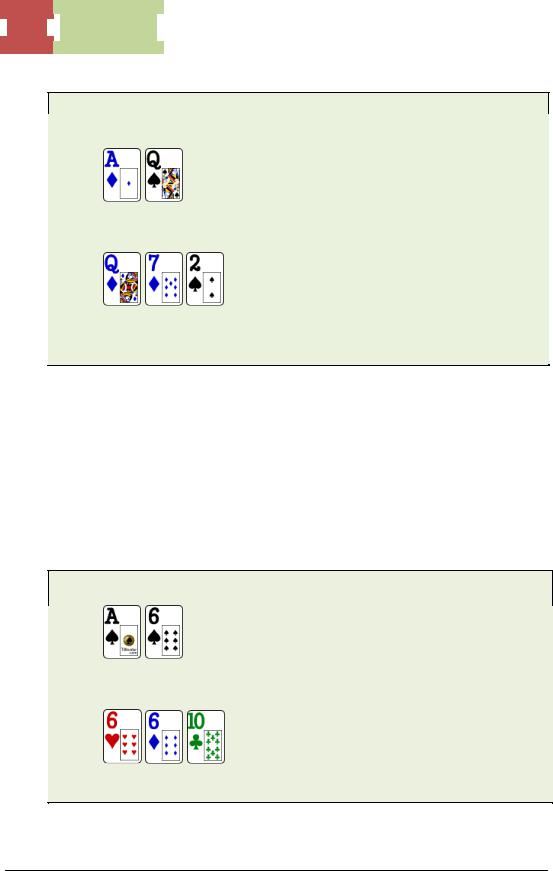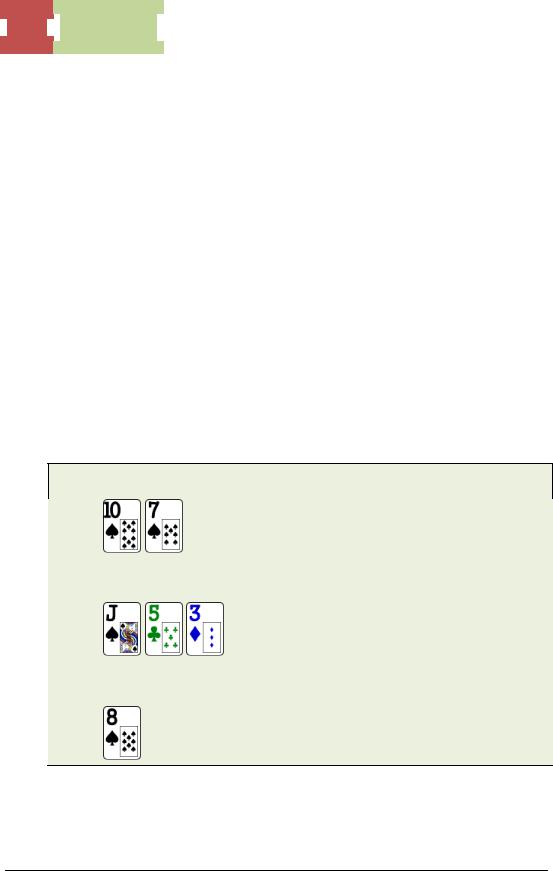
Davis, Aron. The Poker Blueprint
.pdf
 129
129  3-Betting
3-Betting
If he bets the turn, then he probably has an ace, so just fold. There’s nothing wrong with folding the turn after floating the flop. If Villain checks the turn, then check behind to represent something like A5s going for pot control. When he checks again on the river, he rarely has an ace. You can now bet about 2/3-3/4 of the pot.
© 2010 Aaron Davis and Tri Nguyen - All Rights Reserved.
http://www.DailyVariance.com
129

 130
130  3-Betting
3-Betting
Countering 3-bets
Let’s try looking at this from a defensive point of view. You raise from MP and the BTN 3- bets you for the 3rd time. It can get frustrating over time to play someone who constantly applies pressure to you.
How do we deal with that?
Tight strategy
You generally want to be calling 3-bets in position. If at all possible, avoid doing it OOP. If you’re OOP against a good, aggressive player, the best strategy is to simply fold against his 3-bets and tighten up your opening range. Folding is a neutral EV play; it is not a losing play. Unless you want to get into a variance war with the good player, you can tighten up your opening range and wait for a good hand. If you keep folding to his 3-bets, then he’s going to expect you to fight back and stack off lightly. However, you will fight back, when you have JJ+. Villain is going to level himself into calling off with AQs/99-type hands. Just remember that when out of position, it’s a smaller mistake to call 3-bets too tight than too loose.
Playing Fit-Or-Fold
If you want to call with marginal hands, then you have to “play poker” on the flop. You can’t just fold to a c-bet if you miss. Say you have 77. It’s a decent hand pre-flop, but it would be a mistake to call a 3-bet and fold when you don’t hit your set every time. You will not flop it nearly often enough to make it a profitable call pre-flop. Even when you do, you’ll still have to try to stack him off (which is easier said than done since his range is wide and he won’t have a strong enough hand post-flop to stack off). You must be willing to float and make plays if you want to play those pairs and suited connectors profitably.
Let me demonstrate.
© 2010 Aaron Davis and Tri Nguyen - All Rights Reserved.
http://www.DailyVariance.com
130

 131
131  3-Betting
3-Betting
You raise from the CO with
The BB 3-bets and you call. The flop is
He c-bets and you call. The turn is an
He checks and you check. The river is a
He checks. What’s your play?
You should highly consider betting the river since he doesn’t have a strong hand very often. The board on the turn is drawy enough that he would bet any hand that is better than QJ. As for your range, you can reasonably have a flush. If he had a flush, then he would’ve bet the river. You can also have a pair of queens that went for pot control on the turn and is now betting for thin value. You could also rep a rivered two pair. He might end up calling with AQ+ but that’s rarely going to happen. Once he checks the river on this board, he’s going to check-fold most of the time. And since we can beat ace-high, we should bet.
Calling 3-bets with Pocket Pairs
Even with position, you should fold pocket pairs worse than 99 when stacks are less than 150BB. However, if you know your opponent well and know that he’s straightforward enough to c-bet on a J52r and give up on the turn and river, you can call 3-bets with 55+. If you are out of position, unless the opponent is really passive, you should fold these pocket pairs out of position to 3-bets.
© 2010 Aaron Davis and Tri Nguyen - All Rights Reserved.
http://www.DailyVariance.com
131

 132
132  3-Betting
3-Betting
CO vs. BTN
You can actually call with a wider range of hands here versus a button 3-bet because he will have hands like ATs, KTs, and QTs. For this reason, you can call with AQ, AJ, KQ, KJs, and QJs hands and play post-flop. Generally, against an aggressive opponent who has been active, I’m not going to fold if I flop a pair. Barring a disastrous turn and river that put 4 to a straight or 4 to a flush on the board, I’m going to check-call it off. You will lose sometimes when Villain shows up with a real hand, but you will pick off some bluffs as well. Of course, if you see the nuts every time you go into check-call mode against a player who has been 3-betting you a lot, then maybe he doesn’t 3-bet you that often or maybe he does 3-bet you that often but he doesn’t fire multiple barrels as bluffs that often.
Late position vs. 3-bet from blinds
If Villain has a very narrow 3-betting range, then I want to 4-bet to give him a chance to stack off with a range of JJ+/AK, which AA/KK dominates. By calling his 3-bet, he may slow down if the flop is bad for his hand and we fail to stack him.
If an opponent is 3-betting with a wide range, then I will call with my premium hands because I want to balance the times when I have marginal holdings. Against someone who is really aggressive, I will slow-play and then call down all three streets, even if the board gets scarier and scarier, because aggressive players’ bluffing frequencies increase as the board gets scarier. I almost never fold KK+ against them.
I would shove over Villain’s bet on wet flops like T83s because that’s what I would do with my semi-bluffs on this board. If Villain 3-bets a lot and c-bets at a high percentage, then semi-bluffing the flop is insanely profitable since he will bet-fold very often.
On dry boards like Q73 rainbow, I would raise small or flat Villain’s c-bet if he’s the type to pounce on weakness and capable of firing multiple barrels with AK or random hands. This causes him to overplay his marginal hands. A small raise works well against opponents who aren’t very aggressive on the turn or the river. Additionally, there will be times where I will raise small on a flop as a bluff, so I want to do it with a weak hand as well. An argument can be made that if no one is paying attention, then balancing is overrated since your opponents are only playing their cards. Nevertheless, it’s important to develop a sense of how important balance is to your game so you can be aware of it as you move up.
© 2010 Aaron Davis and Tri Nguyen - All Rights Reserved.
http://www.DailyVariance.com
132

 133
133  3-Betting
3-Betting
Don’t jam the flop
Don’t always just get it in on the flop against a 3-better’s c-bet. Almost always call more with sets and two pairs. You probably already do that with medium pairs, so why not do it with the nuts? You don’t want to have an unbalanced range for calling and shoving. Calling the flop with strong hands some of the time will also prevent aggressive villains from putting you on a weak hand and double-barrel bluffing you in the future.
Bluffing the Flop
Players who 3-bet too often also tend to c-bet the flop frequently. Good boards for you to bluff-raise on are connected boards, and sometimes even Kxx or Qxx. Bluff-raising acehigh boards works on some opponents, but it’s better to call the flop c-bet to represent more Ax-type hands. You probably wouldn’t raise a c-bet with AT on A73 rainbow versus someone who 3-bets you pre-flop. You would call instead, and you’d do the same with your other strong holdings since he will bet his pair of aces on the turn anyway. When he checks the turn, check behind. Again, you do that with all your weak aces or smaller pairs.
On the river, if he bets, you can fold since he isn’t bluffing often. If he checks, then you can bet 1/2- to 3/5-pot to take it down.
Inducing a Bluff
Some players never believe you when you raise a fairly dry flop. By raising, you represent such a narrow range of hands for value that a thinking Villain will not give you credit for it. This is probably true because we would slow-play QQ on Q72 suited almost always. We will just call the flop with a weak top pair or medium pair. If Villain is smart enough to recognize when your value range is really narrow, and if he is capable of 3-bet bluffing or floating out of position and betting the river if the turn goes check-check, then a dry board is a great spot to min-raise a c-bet to induce a bluff.
The following example is a hand I played several years back against a tough aggressive player at 5/10.
© 2010 Aaron Davis and Tri Nguyen - All Rights Reserved.
http://www.DailyVariance.com
133

 134
134  3-Betting
3-Betting
He was sitting on several of my tables and I noticed that he would shove all-in on the flop with overcards if you min-raised his c-bet in a 3-bet pot. I picked up
on the button and raised preflop. He 3-bet from the SB and I called. The flop was
and he c-bet. Normally I’d just raise big or shove it in, but after seeing his bluffy tendencies, I decided to min-raise. He immediately shoved with KJo.
Most players at the micro-limits and small stakes are not capable of Villain’s move. The purpose of this example is to show you how you can manipulate your opponent if you pick up on some of his tendencies. If you face a player who is capable of doing it, then you now know how to exploit him.
As you move up in stakes, you will realize that there’s more value to fast-playing your hands than slow-playing. As players get better, it’s more difficult to trap them. However, a lot of players want to make hero calls so if you’re playing your strong hands aggressively, you will get called more often than you think. Here’s another example.
You raise pre-flop with
in the CO and the BB calls. He’s a good aggressive player. The flop is
Villain checks. You c-bet and he check-raises. What do you do?
© 2010 Aaron Davis and Tri Nguyen - All Rights Reserved.
http://www.DailyVariance.com
134

 135
135  3-Betting
3-Betting
Almost everyone calls in this spot. You want to let him continue bluffing his hand. However, if he is smart, he will shut down on the turn, since you will have a hand stronger than Tx way more often than a float. So, if he is aggressive enough, you should 3-bet Villain’s check-raise more often than call. He has been in this spot many times and every time someone calls a check-raise, they have a strong hand. By 3-betting, you are taking a different line and he may go crazy and try to bluff you or float out of position to take it down on a future street.
4-betting
You generally want to 4-bet a hand that either cannot profitably call a 3-bet (A3o, KJo) or that you want to go all-in with pre-flop (QQ+/AK). Having an ace or king in your hand is great because of hand elimination. There is less chance that Villain holds AA, KK, or AK.
Don’t 4-bet with T7o because you want to least have decent equity in the pot if he does call; choose T7s instead. T7s gives you more semi-bluffing opportunities where you can bet the flop with a flush draw and follow through on the turn. You can also bet the flop with a backdoor flush draw and continue the aggression when you pick up a flush draw on the turn.
For example, you c-bet with
on a flop of
and the turn is an
It’s also important that you don’t 4-bet with hands such as 55-88 or T9s. Assuming stacks are deep (150BB), it’s better to just call his 3-bet with these hands because the implied
© 2010 Aaron Davis and Tri Nguyen - All Rights Reserved.
http://www.DailyVariance.com
135

 136
136  3-Betting
3-Betting
odds are high and there are little to no reverse implied odds (your hand is rarely dominated).
Once stacks get deep (150BB+), I would 4-bet with a wide range of hands against habitual 3-betters. There are a few reasons for this. It’s tough to counter my play because stacks are so deep. If I 4-bet big, which is a little more than double his 3-bet size, then he won’t have odds to call pre-flop to play post-flop. I may have aces or kings. Most importantly, players rarely 5-bet bluff shove for 150BB+, and like to play tight when stacks are deep, so I take down the pot pre-flop a lot of times.
© 2010 Aaron Davis and Tri Nguyen - All Rights Reserved.
http://www.DailyVariance.com
136

 137
137  4-Betting
4-Betting
4-Betting
© 2010 Aaron Davis and Tri Nguyen - All Rights Reserved.
http://www.DailyVariance.com
137

 138
138  4-Betting
4-Betting
4-betting is usually a reaction to your opponent’s 3-betting tendencies. A player who has been 3-betting a lot and/or folding to 4-bets frequently is a prime target to 4-bet light against. The standard of today’s game is to 4-bet 2.1-2.5 times the 3-bet size. So if UTG raises to 4BB, and Button 3-bets to 12BB, you should 4-bet to 25BB. This is good for a couple of reasons:
1)If you’re bluffing, then you risk less than a third of your 100BB stack and force your opponent to risk his entire stack.
2)If you’re 4-betting for value, then you also encourage Villain to come along with hands that might fold to a shove. You may also induce him to 5-bet shove with a worse hand.
You never want to put in more than 30BB of your stack pre-flop because you do not want to commit to the pot with a weak hand. If you 4-bet to 40BB and he shoves, you would need to call 60BB to win 140BB—roughly 2.3-to-1 odds. This means you will have to call a shove with a hand as weak as A2s or 65s against his shoving range of QQ+/AK.
Playing TT and JJ
If you have been 4-betting small with these hands, then you’re losing a lot of value. You may decide that you want him to shove with random hands such as T8s or Q4s. While that may sometimes work, players will usually just fold those hands. People 3-bet bluff less than we think, 4-bet bluff even less and 5-bet bluff very rarely. So you gain very little by 4- betting him there.
You might even induce AQ, AJ or KQ to shove over your small 4-bet. That’s a big mistake because you want him to fold and allow you to rake in the dead money. Had he folded, he would have lost his equity share of the pot without seeing the flop. But by 4-betting small, you encourage him to shove with hands that still have 43-percent equity against you. So I would just shove it in here with TT and JJ, 4-bet bigger so he knows you’re committing yourself, or call his 3-bet.
If he 3-bets light against you and you’re OOP, then you should 4-bet big or shove. Against passive opponents who don’t barrel enough, calling is optimal because you have more chances of seeing showdowns with TT and JJ. If he’s a nit who rarely 3-bets you, then you should fold to his re-raises when you open from UTG or UTG+1. Players will save a lot of money if they treat TT and JJ like 99.
© 2010 Aaron Davis and Tri Nguyen - All Rights Reserved.
http://www.DailyVariance.com
138
